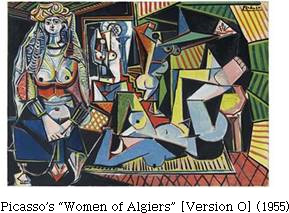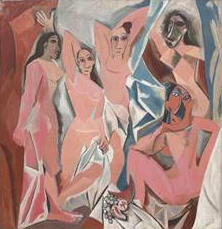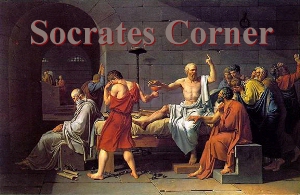Picasso: psychotic pervert or iconic genius?
I am a Communist and my painting is Communist painting.
~ Picasso
Prologue to Picasso: Psychotic or Iconic?
On my Facebook page last week I poised a series of perhaps rhetorical questions regarding the Spanish-French painter, Pablo Picasso (1881-1973). I asked: “Is Picasso a great artistic genius or are his paintings the perverted scribblings of a morally degenerate mind who should have been locked in a cage at an insane asylum? Picasso’s famous painting, Women of Algiers (Version O), above is poised to be sold later this month for the highest price in art history – $140 million. Is it worth it? How much would you pay for this painting?”

“I don’t necessarily agree that all of Picasso’s work or even most of it is ‘negative.” Picasso was likely one of the most prolific artists of all time, sometimes painting for weeks at a time. On the other hand, some of his work is by necessity tortured, (the mural of Guernica comes to mind) it would take a very untutored mind, as well as a negligent eye (and Picasso had a nimble mind and an almost eidetic eye) to be blind to the vortex of coming death and destruction that constituted the 1930’s in Europe,” Joseph Mazon wrote. “Curiously, no one criticizes Orwell for seeing the edge of the abyss creeping ever closer, nor Franklin Delano Roosevelt, nor Winston Churchill. All the great minds of the age, whether artists, writers, poets, intellectuals, generals or many world leaders could see the writing on the wall. Even Stalin’s apologists purposely sacrificed objectivity for the sake of ideology, but they too knew the truth. And no one with a brain after 1933, could fail to see the face of evil itself slowly rising in Germany. After 1936? – It was no longer a matter of if, but only of when,” Joseph continued. “Picasso’s beloved Spain was torn by a Civil War which was in essence a laboratory for WWII and its unnumbered atrocities. While the Spanish Civil War was waged in a land known for its passion and its unique mixture of bravery and cruelty, it was a preview of things soon to come. Spain’s agony, while desperate, paled in comparison with the 40 million deaths caused by World War II.”
Surprised and impressed by Joseph’s enthusiasm and passion regarding the subject of Picasso and his proper historical legacy, I remarked, “You should read Arianna Huffington’s 1988 book on Picasso: Creator and Destroyer. It is a very good read. I read it in the early 1990s and wrote Arianna shortly after email was invented and she wrote me a nice message back. Of course this was before she made the ideological jump from conservatism to Socialism after her failed California gubernatorial run against Arnold Schwarzenegger in 2003, and then went on the be the founder and Editor-in-Chief of one of the most important internet news blogs, The Huffington Post in 2005.”
Picasso the Minotaur and his Relationships (Causalities)
In Greek legend the Minotaur was a creature with the head of a bull on the body of a man. The demigod Theseus killed the Minotaur in the labyrinth caves on the Isle of Crete. Picasso was obsessed with the Minotaur figure as a symbol of himself. He lusted after its raw, primitive power and merciless savagery, and it appeared in many of his paintings throughout all of his many periods. Picasso was the Minotaur and used his merciless method savagery and sexuality to utterly dominate all of the people in his life, particularly his two wives and many mistresses and concubines.
What was most noteworthy to me and other conservatives which conversely was controversial to Progressives and the hedonist Left that controls and dominate the artistic community throughout the world, was Arianna’s very readable biography that focused not only on Picasso’s extraordinary accomplishments and prolific output virtually unmatched in the artistic world. Arianna’s biography of Picasso meticulously exposed the disturbing, often times pathological truth about his predacious worldview regarding his relationships; his synthesis of his predatory sexual lusts with his prolific artistic output which some critics including Freud thought made Picasso a classic psychotic. (More on this aspect of Picasso later).
Indeed Picasso’s entire life was an existential struggle between his nature to create and his instinct to destroy that was a major theme of Arianna’s book. The evidence of Picasso the creator is infinite and celebrated; his inexhaustible creativity like his alter ego, the Minotaur, is virtually mythical. Through his thousands of images Picasso painted history, a comprehensive, yet disturbing, even psychotic vision not only of the art world but a visual critique (a psychotic condemnation if you will) on the entire twentieth century. The indication of Picasso the destroyer is on a human level exceedingly grotesque. The suicides of his second wife, of his grandson and of Marie-Thérèse Walter, his favorite mistress who endured his sadistic emotional abuse for so many years; the psychotic breakdown of his first wife; the nervous breakdowns of Dora Maar, a wonderful artist in her own right who was his mistress during the time of Guernica (1937) – all tragic casualties of a terrible number of victims who like Icarus, Son of Daedalus, dared to fly too near the sun on wings of feathers and wax. There is a historical connection to Daedalus who had been imprisoned by King Minos of Crete within the walls of his own invention, the Labyrinth, and the Minotaur whose lair was the Labyrinth, a leitmotif Picasso returned to repeatedly. Indeed it could logically said that Picasso didn’t have friends or family or associates, but he had casualties (corpses) of his personality.
Picasso and the Communist Party
Arianna’s explanation of why Picasso joined the Communist Party in 1944 is perhaps one of the most enduring aspects of her book because she does so eloquently, passionately and with no apologies unlike the legions of other books on Picasso have done before and after Huffington; most of which either ignore or rationalize Picasso’s communist beliefs. Arianna quotes from Picasso’s explanation, published in L’Humanité: “Were not the Communists the bravest in France, just as they were in the USSR or my own Spain? … The Party has opened its arms to me, and I have found in it those that I most value, the greatest scientists, the greatest poets,” Picasso proclaimed. “Never before had he so thoroughly poisoned the well of truth,” Huffington writes of Picasso’s piece in L’Humanité:
- Was he incapable of comprehending the magnitude of the suffering imposed by Communism, the millions murdered or incarcerated in concentration camps, the simple fact that, morally, Stalin was no better than Hitler? Or did he believe that the end justified the means? The reports coming out of Russia provided ample evidence that Stalin and his pack meant business. Picasso worshipped strength and despised weakness. Weakness smelled of death to him … he admired totalitarianism. He was fascinated by its apparent efficiency and its sheer power.
Although Arianna tries in vain to discover why Picasso had not given his support to Franco or to Hitler, she does provide a historical background earlier in the book where Huffington quotes one of my favorite historians, Paul Johnson’s description (in his book Modern Times) of a party at the Kremlin after the signing of Hitler’s non-aggression pact with Stalin: there was a “sudden discovery of a community of aims, methods, manners and, above all, of morals.”
Epilogue: Picasso, Freud and Sexual Pathology
Picasso’s primary triumph was to become the twentieth century’s artistic guide to discover the limits of human sexuality, thus, he projected raw sexual force, absent all restraint, and simultaneously he was misogynistic and hated women as devouring monsters. (Here, this demonstrates Freud’s Psychological Projection because in reality Picasso was the monster).
Another philosophical way in which he reflected the twentieth century was in his venal, even psychotic hatred of God and the divine. He would drive religion away from his presence at every opportunity and watch in frustration and rage as God’s presence in images returned to him again and again. Though he proudly and repeatedly declared his atheism to the world, in dozens of painting he identified with the crucified Christ and reverted to this leitmotif in every period of his artistic development. In an paradoxical way I believe that Picasso’s love-hated of God kept him alive for the nearly 100 years he had on earth.
Picasso was a man of his times; the foremost witness to the blackness and genocide of the century, a century controlled by communist, fascist and Nazi political ideologies in the name of which revolting grotesqueries were committed. In 1944, Picasso proudly joined the Communist Party, yet in a large part of his work he shinned the light of truth through his singular artistic genius onto the profound depths of wickedness in man like few other artists in history could ever conceive. Like Freud, the father of psychoanalysis and the psychiatry of the human condition, Picasso saw deeply and truthfully into the tortured sexuality, violence, and suffering of civilization. Here is where Picasso Will to Power triumphed most exceedingly.
Picasso, like his savage alter ego the Minotaur, fell into the existential tragedy that while sanctifying deconstruction and nihilism in his art, he lived it just as ruthlessly in his life. Obsessed about death, Picasso believed that the world was evil, thus he brandished his art as a medieval cudgel and vented his rage, torture and his vengeance onto people closest to him in images and paintings alike. “A good painting,” he explained, “ought to bristle with razor blades.” And a good relationship too.
These progressions of the human psyche that Freud defines previously existed in the culture through art that was being produced decades before. Artists of the post-impressionist and cubist styles were adopting Freud’s psychological theories like the Oedipus Complex, Repression, Psychological Projection, Id, Ego, Superego, Psycho Sexual development, Life and Death drives, Religion, etc. despite the fact that it may have been done on an unconscious level. These artists, like Van Gogh, Gauguin, and Picasso are all celebrated in their accomplishments yet these artists are on every human level, far from conventional in any respect.

Notwithstanding, Les Demoiselles d’Avignon defied virtually every artistic standard to the same degree as the effect of the atom bomb dropped on Hiroshima and Nagasaki which immediately and forever changed the world and the history of warfare. Picasso had forsaken realism and complexity in favor of hyperbolic structures and a rigorously two dimensional images. This rebelliousness against artistic convention and history provoked passionate controversy launching Picasso as the central figure of the Avant-Garde movement.
And now we end with the same rhetorical question where we began – Picasso: Psychotic pervert or iconic genius? I think he was both a psychotic (what great artist isn’t?) and virtually since his first painting, history has made him iconic as demonstrated in this famous quote – When someone commented that Gertrude Stein, the American novelist and playwright did not look like her portrait, Picasso prophetically replied, “She will.” Picasso was right. English historian and biographer, Paul Johnson who did a complete chapter on Picasso in his book Creators: From Chaucer and Durer to Picasso and Disney (2006), wrote that, “The most evil person I ever met was a toss-up between Pablo Picasso and the publisher-crook Robert Maxwell.” Ironically, Paul Johnson’s father was a painter and ran an art school but told his son, aged six: “You’ve got a bit of talent, boy, but don’t become a painter because bad times are coming for art. Frauds like Picasso are going to rule the roost for the next 50 years.” Johnson, whose views on modern art, and Picasso in particular, are abrasive, adds: “He was right about that.”
What I abhor about the political Left, particularly Marxists and Socialists monopolizing and dominating art, even in modern times, is that now all art is the subjective slave of the omniscient Art Critic. You are deified as iconic or a genius if the artistic apparatchik community gives you the nod as they did Picasso. Artistic genius is essentially dead because it is irrevocably perverted since we have not objective, non-Marxist critique upon which to judge art. Today there exists no real aesthetics apart from a militant Marxist-Socialist-Progressive politics. However, I long for a return to a pre-Avant garde era where the criteria of every human creation should and must be judged upon – God, History, Transcendence, Relevance, and Veritas (truth).
Ellis Washington is a former staff editor of the Michigan Law Review and law clerk at the Rutherford Institute. He is an adjunct professor at the National Paralegal College where he teaches Constitutional Law, Legal Ethics, Contracts and Advanced Legal Writing.
A founding board member of Salt and Light Global, Washington is a co-host on “Joshua’s Trial,” a radio show of Christian conservative thought.
A graduate of John Marshall Law School and post-grad work at Harvard Law School, his latest law review articles include: “Nigger Manifesto: Ideological Racism inside the American Academy” (forthcoming) and “Social Darwinism in Nazi Family and Inheritance Law.”
Washington’s latest book is a 2-volume collection of 230 essays and Socratic dialogues – “The Progressive Revolution” (University Press of America, 2013). Visit his new law blog, NiggerManifesto.com (formerly EllisWashingtonReport.com), an essential repository dedicated to educating the next generation of young conservative intellectuals.
© Copyright 2015 by Ellis Washington
http://www.renewamerica.com/columns/washington/150507
Category: Commentary







What a terrific column. I always, even as a child, found Picasso’s work grotesque. Thank you for validating my observations with a more thorough understanding of the so-called artist.
I also concur with your sentiments regarding modern “art”. When a vulgar monster such as Andres Serrano is celebrated, society’s moral compass is damaged.